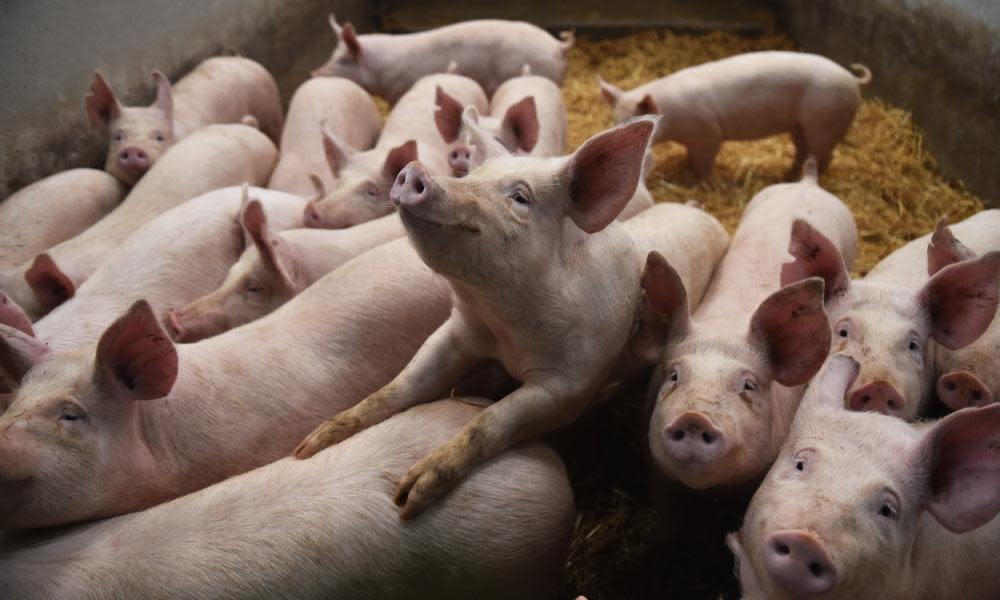‘The government doesn’t care’: UK pig farmers voice alarm over shrinking sector

“If they don’t make money, let’s get rid of them and switch to something else,” says Flavian Obiero, who manages an indoor pig farm in East Sussex.
Obiero’s boss hasn’t had to heed his advice just yet, but after a torrid few years the UK’s remaining pig farmers are a shrinking group. The UK pig population has fallen from about 8 million in the 1990s to just over 4 million today.
The decline is not from a lack of consumer demand for bacon and pork. We imported £2bn-worth of pork products last year. But shrinkage in production from UK farms seems to be unique to pigs.
While cattle, sheep and poultry numbers on farms remain high despite their own various well-publicised crises, the pig sector gets smaller. The UK is largely self-sufficient in beef, lamb, dairy, chicken and eggs, but the figure for pork products is 40%.
A largely overlooked development late last year encapsulated one reason for this contraction: the meat giant Danish Crown’s announcement that it was building a new multimillion-pound bacon factory in Rochdale – but that it would only use imported meat from Denmark.
British pigmeat was too expensive, chief executive Jais Valeur told Reuters, as he explained the new factory would allow the company to adapt more quickly to supermarket gammon and bacon demands.
Could you imagine going to Germany or Denmark and building a factory and only bringing in pigs for it from the UK?
Flavian Obiero, pig unit manager
It was another reality check for the UK’s remaining pig farmers.
“Could you imagine a UK meat producer going to Germany or Denmark and building a factory and only bringing in pigs for it from the UK? The government here doesn’t care,” says Obiero.
“And we have to stop thinking supermarkets will save us. They won’t. We saw that with imported eggs [before Christmas],” he adds.
UK consumers have long eaten Danish bacon, but the latest move caps a catastrophic year for the UK’s pig sector.
Farmers are used to the cyclical nature of the market – which had been very profitable for many in 2019-20 – yet the recent period of inflated feed and energy costs has made continuing in the business impossible for some.
The Guardian has spoken to farmers who had been offered as little as £60 or less for their pigs at one point last year by meat processors.
“You were losing money keeping them on the farm and feeding them and the meat buyers knew that so it was a price to take them off our hands,” says Nigel Lloyd, who was forced to close his pig farm near Shrewsbury as a result of rising feed prices, which make up the majority of pig farmers’ costs.
“I doubt there would be many independent producers left. The bigger ones will be clinging on and hoping for higher prices from a smaller sector in the future. Or they maybe can’t exit because they have too much invested in their businesses,” says Lloyd.
Industry experts say the number of “significant-sized pig producers” left in the UK is likely to be “in the hundreds now” with pig numbers also in decline. It’s a far cry from the 1970s, 80s and 90s when the pig population was about 8 million and Britain had high levels of self-sufficiency.
A meat buyer told the Guardian it had been “heartbreaking” to see so many pig farmers struggling and forced to accept prices below cost of production, but that “most farms would be breaking even now”.
The problem for farmers was that many people were not bothered about buying non-British bacon, the meat buyer said, and retailers knew that.
The biggest hit to the UK’s pig population happened in the late 1990s as a government ban on the use of gestation crates, combined with a rise in the value of sterling and a pork glut in Europe resulted in pig farm numbers almost halving.
The UK moved more quickly than other European countries in banning the practice of keeping pregnant sows in narrow stalls or chains throughout their pregnancies. These prevent pigs from moving properly and carrying out natural behaviours such as rooting. The EU didn’t ban the practice until 2013.
The hope had been that shoppers and retailers would support higher welfare pig meat. Instead, UK pig meat imports from Denmark rose by 50% and from Germany by 400% between 1997 and 2007.
Shane McAuliffe, a pig producer from county Kerry, says the UK is paying the price for implementing higher welfare standards.
“There’s no denying the UK has higher welfare standards. They [supermarkets] say they back British, but when you see the shelves they don’t. They’re just content to pick up what they need from Europe.”
For Obiero, staying in the sector long-term will require making better use of local and global markets. The farm already has a shop, but he would also love to start producing his own cured meats, which are mostly imported from Spain, Italy and elsewhere in Europe. “We can’t let it [UK pig farming] collapse,” he says.

 Yahoo News
Yahoo News 
